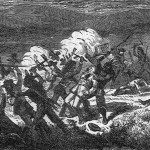We do a few more spiral dives, which I counteract myself. He tells me more about physics and perception and how they interact. My sense of what obvious means changes some. I learn to not die in an airplane today, and enjoy doing it.
On another day, John hands me a parachute pack and tells me to put it on. I've never worn one of these before. He gives me a quickie lesson on how to use it. There is no trial run. That's because we aren't here to learn about skydiving. John is going to teach me about spins, and the law requires us to wear parachutes when doing that. If we break the airplane apart in midair, I have at least a chance of surviving.
A spin is one of those things you usually only see airplanes do in movies or on TV. The plane is twirling around and around, headed straight for the ground. This is what killed John Kennedy, Jr. People learning to fly powered planes like Kennedy's are told about spins and how to get out of them. People learning to fly gliders have to go up and actually do it.
We fly out over the red salt ponds that make up the southern part of the San Francisco Bay. This glider is much more advanced than the previous one: it flies faster and glides farther. Flying straight and level, John pulls back on the stick ever so gently. I watch the needle on the airspeed indicator drop slowly to the red line on the gauge. Go below that line, and the plane stops flying and starts falling. John is an artist, dancing with this magnificent machine up against the stall line. Gliders really do like to fly, but this thing is shuddering and fluttering like a person on the edge of an orgasm. You know that any little thing will push it over the edge. Some edge. Any edge.
"Now, watch what happens when I do this."
I feel John give the plane just the tiniest little bit of rudder. The world goes berserk. The plane rolls over onto its back, then points down and heads for the ground, spinning wildly out of control. The view out through the canopy is like something in a terror movie, but I'm not sitting in a theater. In the back seat, John is talking to me calmly, like he always does, asking questions, telling me what to notice. I'm sure I'm going to die. He shows me what to do. I don't die. We do it again, several more times. Like the spiral dive, the way out of it is not obvious. Unlike the spiral dive, the way out of it requires a little bit of finesse and a whole lot of courage. Then we fly back to the airport and land.
But the most interesting part of the day happened after I had the plane on the ground and pulled it up to a stop. I popped open the canopy, unbuckled my safety harness, took off the parachute, and started to get out of the plane.
"GET BACK IN THAT AIRPLANE! PUT ON THAT PARACHUTE! BUCKLE YOUR HARNESS! CLOSE THE CANOPY!"
I want you to understand that John never yells. He is so even-tempered. I am in shock, but I do as he commands. Then he says:
"Open the canopy."
I do.
"Unbuckle your harness."
I do.
"Get out of the airplane."
I do.
"Now you may take off your parachute."
I ask him what the hell all that was about. He tells me.
"You see, people are creatures of habit. Most people will do what you just did before I yelled at you, and they get used to doing that. Then they find themselves at umpteen thousand feet in an airplane that is coming apart. So they do what they're used to doing: they open the canopy, unbuckle their harness, take off their parachute, and leave the airplane."
I stare at John in disbelief. He continues:
"This has happened more than once. But never more than once to any one person."
It's another day, and another lesson. Today, we never leave the airport's little office. We talk about flying. John proposes situations and asks me what I would do to handle them. Here's one:
"You're being towed up to altitude by the tow plane. At a little over 100 feet, you notice the tow plane waggling its wings, telling you that he's having a problem and you need to unhook from him. So you pull the big red knob to release the tow rope. It doesn't work. You pull it again. It still doesn't work. So you waggle your wings back at him, telling the tow pilot that you can't get off. That's when you notice the tow plane has lost power and is going down with you still attached to it and no friendly runway in your future. Your passenger in the back seat has noticed this, too. He pulls the canopy latch, and the canopy flies open, making the airplane much harder to control. He is screaming that we're all going to die, while trying to jump out of the plane. What do you do?"
I think. That's the first thing. Think. But don't take too long about it, because reality is about to descend upon me in a major way. I start telling John all the things I would do. There is a lot to tell. When I think I've said everything I can say, I'm nervous, hoping I thought of all the things John would want me to think about. He says:





